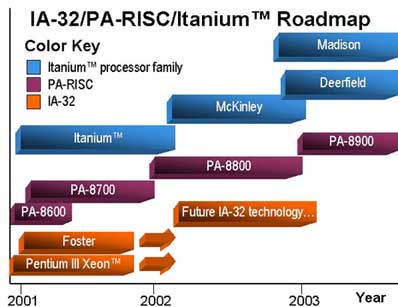The Itanium is of course the very first IA-64 processor, designed, amongst others, to develop software on and create experience with designing chips that make use of the new architecture. And Itanium is useful to test motherboards and chipsets. To put it bluntly: the Itanium is a try-out. Intel seems to think likewise, they expect to sell at most a few dozen, also because the applications for the processor will be very limited as a result of the high price and the lack of software. The road from IA-32 to IA-64 will be long and there's just scraps of information about it.
 |
The first IA-64 processor that will have serious applications will be the McKinley, it will succeed Itanium in 2002. McKinley will have a 10-stage pipeline, 3 more than the Itanium. This should enable it to reach 1GHz at its release at the end of 2001, making it about twice as fast as the Itanium. McKinley will, like Foster, the server version of Pentium 4, make use of the i870 chipset with support for DDR SDRAM and RDRAM. By that time there will probably have been enough software development on the Itanium but it's questionable whether costs will drop. Yields won't improve much because Intel wants to integrate 4MB L3 cache, consisting of nearly 300 million transistors, on die.
To lower costs Intel wants to migrate to the cheaper .13 micron production process and end 2002 the first IA-64 processor will take this road. This chip is codenamed Madison and is the successor to McKinley. The smaller die size however is not the only development that will take place during this time, Intel wants to go to mid end servers/high end workstations by releasing a cheaper version of Madison. This processor, of which we only know the codename Deerfield, will be not nearly as fast but will have a price tag that is much more acceptable.
  |
![]() The competition:
The competition:
![]() As a side note to this article something about x86-64, AMD's answer to IA-64. Both architectures are 64 bit but as opposed to Intel AMD has not gone through the trouble of making a new design. Instead, their existing architecture has been extended with a number of 64 bit tricks. The first x86-64 processor will be the Sledgehammer that will be introduced in the beginning of 2002. With Clawhammer, a cheaper version of Sledgehammer, Amd targets the consumer right at the launch of the architecture. The advantage of AMD's approach is that it costs a lot less money and offers much better support for existing software; disadvantage is that the architecture is still based on the aging x86.
As a side note to this article something about x86-64, AMD's answer to IA-64. Both architectures are 64 bit but as opposed to Intel AMD has not gone through the trouble of making a new design. Instead, their existing architecture has been extended with a number of 64 bit tricks. The first x86-64 processor will be the Sledgehammer that will be introduced in the beginning of 2002. With Clawhammer, a cheaper version of Sledgehammer, Amd targets the consumer right at the launch of the architecture. The advantage of AMD's approach is that it costs a lot less money and offers much better support for existing software; disadvantage is that the architecture is still based on the aging x86.
